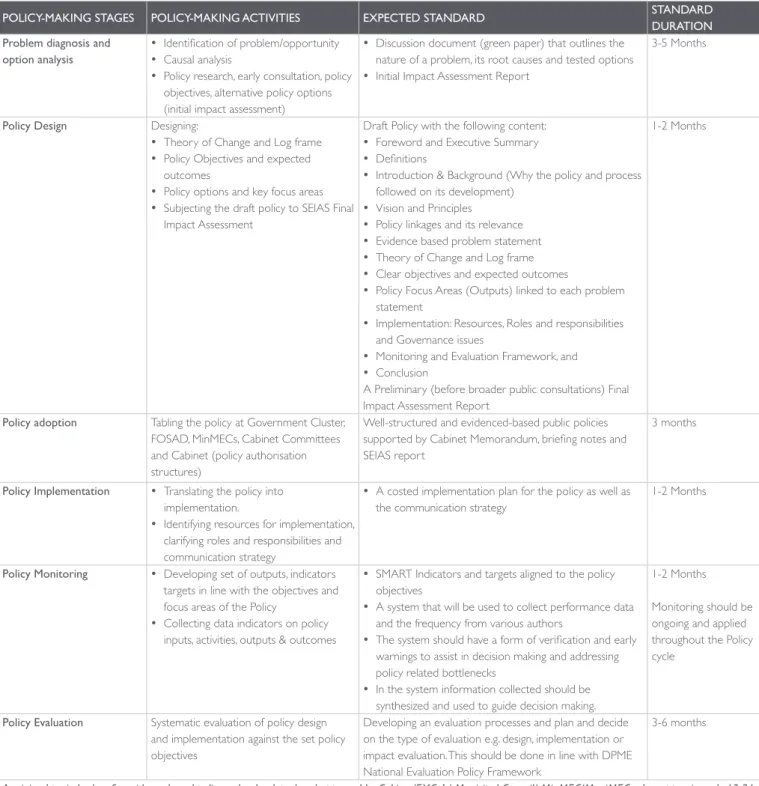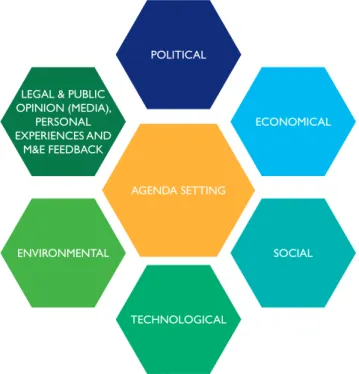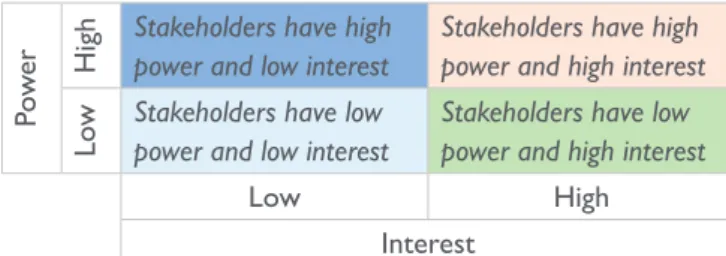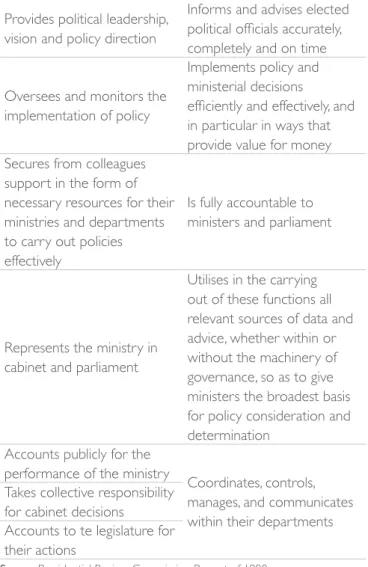In doing so, it will lay the foundations for policy development (codification of practice and process), coordination, policy-making cycle, expected standards and institutional arrangements to be put in place for effective policy development and implementation. It will also contribute to inculcating a culture of evidence-based policy making for better service delivery. The National Policy Development Framework seeks to embed good public policy-making practice in South Africa by establishing clear principles for effective policy development and implementation.
The Constitution of the Republic of South Africa states that the needs of the people must be responded to and that the public must be encouraged to participate in policy making. However, policy-making challenges prevail in the country, as the government does not have a standardized or systematic approach on how to develop evidence-based policy in South Africa. In doing so, policy-making standards and guiding principles are introduced for the entire policy-making cycle.
It aims to embed the socio-economic impact assessment system (SEIAS) in the policy-making process. Lack of data-driven policy decision-making and a slow transition from opinion-based policy-making to evidence-based policy-making;. A tendency to separate initial impact assessment (SEIAS) from the policy-making process, meaning a lack of critical due diligence in devising alternative policy options during the impact assessment phase;
Lack of competence to complete the policy-making cycle resulting in poor practice of ex-post impact assessment (inadequate use of evaluation findings to improve policy processes, programs and inform new policies and plans);
WHY DO WE NEED PUBLIC POLICIES?
TEN THESES OF EFFECTIVE PUBLIC POLICY
Costs should be calculated and stakeholders consulted prior to approval, while SEIAS should help minimize costs through innovation and partnerships. j) Good communication - people need to know. The public will be aware of services that will be implemented through the policy, cooperate with and hold government accountable, and provide feedback on policy experiences as it is implemented.
TYPES OF GENERIC POLICIES
THE PROCESS OF POLICY MAKING IN SOUTH AFRICA
Communication within government is for buy-in, clarity about assigned roles and responsibilities, and implementation mechanisms. The public will know about services that will be implemented through the policy, engage with and hold government accountable, and provide feedback on policy experience as it is implemented. framework for the other plans for national, provincial and local authorities. The detailed actions of the MTSF are discussed in the cabinet and Makgotla province and announced to the public through the state/provincial/municipal addresses.
Strategic Plans, Municipal Integrated Development Plans (IDPs), Annual Performance Plans (APPs) and Municipal Service Budget and Implementation Plans (SDBIPs). d) Administrative Policy: Administrative Policy is intended to give practical effect to the broader political and governmental policies adopted by political office holders within the national executive. This policy gives direction to the day-to-day affairs of the department and relates to personnel policy, financial, organisational, procedural and control policy. Taking into account the Constitution, PESTEL, NDP, IDP, PGDS, Sector Policy International Obligations and etc.
Note: Since policy making and legislative development are inextricably intertwined and interrelated, it should be a principle that no legislation (bills and amending bills) should be developed in the absence of a policy document (green and white papers). School Admissions Policy or the National Policy Framework on Child Justice Policy, drafters must do this in collaboration with legal drafters and the Office of the Chief State Legal Advisers.
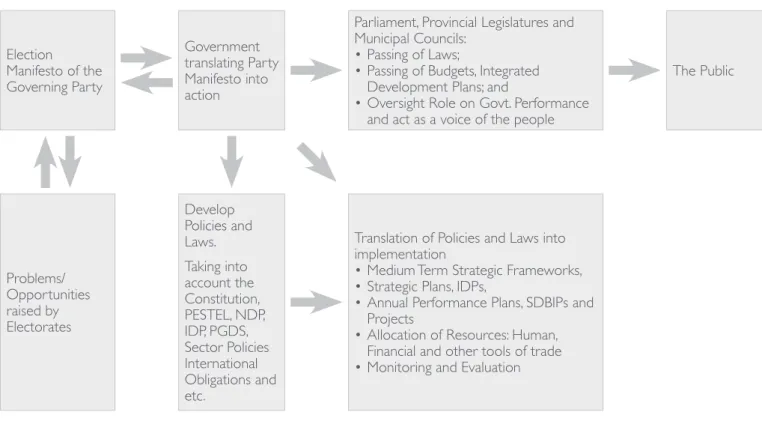
THE POLICY MAKING CYCLE Figure 2: The Policy Making Cycle
POLICY FORMULATION
POLICY EVALUATION
POLICY ADOPTION
POLICY IMPLEMENTATION
- POLICY MAKING STANDARDS
- FACTORS INFLUENCING POLICY-MAKING
- STAKEHOLDER ENGAGEMENT IN POLICY-MAKING Chapter 10 of the Constitution prescribes that people’s needs
- INSTITUTIONAL ARRANGEMENTS FOR EFFECTIVE POLICY MANAGEMENT
- QUALITY ASSURANCE AND VETTING OF POLICY PROPOSALS
- CONCLUSION
- REFERENCES
Not be based on personal interests but be supportive of the government of the day;. Legitimacy: it must enjoy the support of the major stakeholders involved in the policy issue area (eg participants, target groups or funders). The table below shows activities and time estimates to be ensured for each phase of the policy-making process.
Policy monitoring • Development of sets of results, objectives of indicators in accordance with the objectives and focus areas of the Policy. Various court cases have clarified the role of the state in the progressive realization of socio-economic rights, especially related to access to adequate housing. In terms of Article 231 of the Constitution, the national executive has the responsibility of negotiating and signing international agreements.
Therefore, public involvement in policy-making is a constitutional obligation that government institutions must respect and institutionalize. In addition, policymakers should consider setting the rules of the game, the agenda, and agreeing on a process that will shape policymaking. Policy makers should not impose their preconceived ideas and attitudes and be too quick to influence the outcome of the policy consultation process.
According to the constitution, section 156 (3), these statutes must not conflict with national or provincial legislation. This process requires evidence and the use of IIA to justify the necessity of a policy. The president chairs the cabinet meetings as head of the national executive.
FOSAD was established to improve coordination in the implementation of the government's agenda and strategic priorities. The state and interest groups in a framework of multi-level decision-making: the case of the European Union. Course Evidence for Policy Making and Implementation: Interview with the Director General and Secretary of the Cabinet during the Presidency, R.
Nature, history and scope of the problem (including trend identification and assessment-use of evidence) 3. Depending on the nature of the policy, work with Legal Services to draft a bill/law to give effect to the implementation aspects of the politics. The relevance of evidence to the policy context and the legitimacy of evidence in the eyes of policy actors are equally important.
Be aware of the difference between the quality of a single piece of evidence (which we assess using critical appraisal) and the quality of a body of evidence (which requires assessing the strength of the evidence base as a whole).
